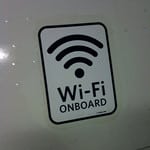It has been five years since American Airlines first launched Wi-Fi on its domestic flights in the U.S. and, frankly, since that time, Wi-Fi on airplanes is still stuck on the runway. It’s expensive, slow and based on GoGo data, less than 10 percent of flyers even attempt to use the service, even if someone else is paying for it.

Wi-Fi first showed up on flights five years ago and hasn’t really improved for the average passenger. Photo by Clintus McGintus.
So as entitled as we might feel to the same Wi-Fi experience in the air as we have on the ground, it’s not going to happen overnight. It’s going to cost more, have less capacity and come with limits. Don’t blame the airlines (or worse, the flight attendants): blame physics. After all, getting a mobile connection in a metal tube flying at a speed of 500 miles per hour is actually pretty freaking phenomenal.
Since network connectivity is the largest continuing cost of Wi-Fi on planes, it’s clear to see why the services are so expensive. It’s also why they are so slow.
Subscribe to Skift Pro to get unlimited access to stories like these
{{monthly_count}} of {{monthly_limit}} Free Stories Read
Subscribe NowAlready a member? Sign in here
Subscribe to Skift Pro to get unlimited access to stories like these
Your story count resets on {{monthly_reset}}
Already a member? Sign in here
Subscribe to Skift Pro to get unlimited access to stories like these
Already a member? Sign in here
